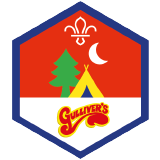Chase the shape
You’ll need
- Pens or pencils
- Scrap paper
- Access to a computer
- Access to a printer
- Ink stamps, stickers or colourful pens
- Clear pouches (optional)
Before you begin
- Use the safety checklist to help you plan and risk assess your activity. Additional help to carry out your risk assessment, including examples can be found here. Don’t forget to make sure all young people and adults involved in the activity know how to take part safely.
- Make sure you’ll have enough adult helpers. You may need some parents and carers to help if you’re short on helpers. Make sure you have enough helpers for each person to hold one of the shape cards. If they’re a parent or carer helper, give them a spare scarf so it’s easy for people to recognise them. You’ll probably need a volunteer or two to keep an eye on the whole game too.
Setting up the activity
- Print out enough copies of the shape cards. People can play in teams, in pairs or individually.
- If you don’t have access to a printer, you could draw the cards on paper. Make sure that each card has the shapes in a different order.
- Print off one of each shape. You could place them in reusable clear pouches so it’s easier to clean them and use them again.
- Decide how the volunteers will mark off their shape on the cards. Could they use a stamp, sticker or coloured pen?
- Choose where you’ll play this wide game. You’ll need a large, open space where everyone can be seen at all times – a park or field is perfect. Don’t forget to tell everyone where to meet.
Play the game
- The person leading the game should explain the area and boundaries, so everyone knows where they’ll be playing.
- Everyone should split into pairs or teams. If people want to play on their own, that’s OK too.
- Each pair should collect a shape card and pen or pencil.
- The volunteers with the shape cards and stamps, stickers or pens should spread out across the wide game area. Once the game begins, they should move around the area.
- Each pair should set off to find the volunteer who’s holding the first shape on their card.
- Finding the right volunteer will probably need a bit of trial and error at first – encourage everyone to keep going and remember what they find out from each person.
- Once a pair finds a volunteer, they should ask the volunteer to reveal their shape. If they don’t need the shape next, they should find another leader. If they need the shape, they should ask for the task.
- When a pair asks for the task, the leader should give them a short task, for example, ‘find a leaf’ or ‘pretend you’re a bumblebee’. Once the pair’s completed the task, the volunteer should mark off the shape on their card.
- Each pair should work through their card, collecting the shapes in order. The first pair to finish their card is the winner.
Reflection
This wide game was all about problem-solving and trying something new.
Did people find it easy to keep track of where the shapes were as the volunteers moved around the space? How did they remember who had each shape?
Some people may have remembered the volunteers’ names and the shape, while others may have used other ways of remembering, such as the colour of their shoes.
Did anyone notice that someone else was struggling? How did they help them finish their card? If they didn’t do anything, what could they have done?
People could’ve pointed others towards the adult they needed to go to next – they could even have gone with them if they’d finished their own card.
Safety
All activities must be safely managed. You must complete a thorough risk assessment and take appropriate steps to reduce risk. Use the safety checklist to help you plan and risk assess your activity. Always get approval for the activity, and have suitable supervision and an InTouch process.
- Active games
The game area should be free of hazards. Explain the rules of the game clearly and have a clear way to communicate that the game must stop when needed. Take a look at our guidance on running active games safely.
You could change the number of shapes that everyone has to find depending on how long you have to play, how many volunteers there are or how tricky you want it to be.
You don’t have to use shapes – you could use items, for example, a rock, a leaf, a spoon, a book and so on.
The volunteers could secretly swap shapes to add another level of difficulty.
Choose a place that’s accessible for everyone – you may need to remove certain areas from the game playing zone if they’re too steep or rocky, for example.
Let people choose whether they work alone or in pairs; different people prefer different ways of working together.
Make sure the tasks are accessible for everyone in your group. They don’t have to be physical challenges – you could ask people questions too.
All Scout activities should be inclusive and accessible.


